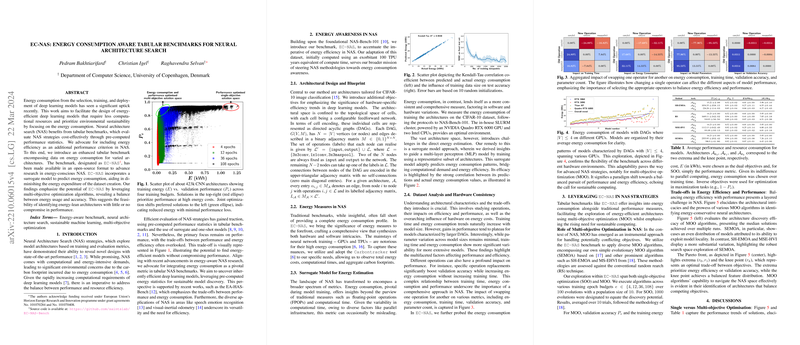The paper "EC-NAS: Energy Consumption Aware Tabular Benchmarks for Neural Architecture Search" addresses the growing concern of energy consumption in deep learning model selection, training, and deployment. The authors focus on enhancing the design of energy-efficient models by emphasizing the importance of energy usage as a critical performance criterion in Neural Architecture Search (NAS).
Key Contributions and Methodology
- Energy Consumption as a Criterion: Traditionally, NAS benchmarks focus on model accuracy and computational cost. This work introduces energy efficiency as an additional dimension to evaluate NAS strategies, aligning with the need for environmentally sustainable AI.
- EC-NAS Benchmark: The authors propose EC-NAS, an enhanced tabular benchmark that contains precomputed performance statistics, including energy consumption data for various architectures. This benchmark is designed to facilitate research focused on reducing the energy footprint of deep learning.
- Surrogate Model for Energy Prediction: To address the high energy cost of dataset creation in NAS, the paper presents a surrogate model capable of predicting the energy consumption of different architectures. This approach helps mitigate the computational and energy expenses involved.
- Open-Source Accessibility: EC-NAS is released as an open-source resource, highlighting the authors' commitment to promoting research into energy-efficient NAS.
Findings
The research demonstrates the efficacy of EC-NAS through the application of multi-objective optimization algorithms, balancing energy usage and model accuracy. Key findings include:
- Energy-Accuracy Trade-off: The paper reveals that it is possible to identify architectures that are energy-efficient without significantly sacrificing accuracy. This underscores the potential for more sustainable model designs in AI.
- Importance of Energy-Sensitive Benchmarks: By incorporating energy consumption into NAS evaluations, researchers can develop models that are both performance-effective and environmentally responsible.
Overall, this paper advocates for an energy-conscious approach in NAS research, providing tools and insights to propel advancements in sustainable deep learning architectures. It represents a significant step towards reducing the ecological impact of AI technologies.
